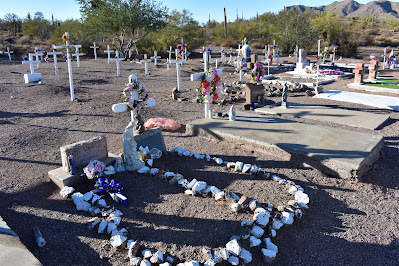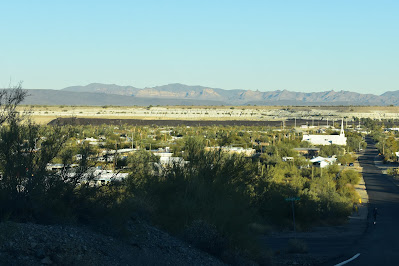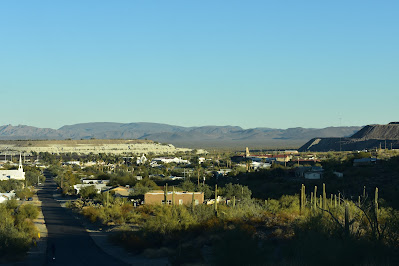Saturday, December 19, 2020
For some reason "Backing Up" sounded better then "Catch Up"...LOL Today we did some driving around Ajo. More on that tomorrow.
Tuesday, December 15, 2020

We had not so this afternoon we got in our Jeep and
followed Doug and Yuma over to were it is.
The land for this cemetery was donated by Ernie and Lorraine Eiler to be used as Burial Grounds for Native Americans. It is a Hia-Ced O'odham cemetery. Darby Wells was once a native community that was located nearby.
There is little information about this Cemetery or Darby Wells online. What I found when I searched was the information above and some nice pictures taken by other bloggers.
I did find this information online: The Hia C-eḍ Oʼodham ("Sand Dune People"), also known as Areneños or Sand Papagos are a Native American peoples whose traditional homeland lies between the Ajo Range, the Gila River, the Colorado River, and the Gulf of California. They are currently unrecognized at both the state and federal level in the United States and Mexico, although the Tohono Oʼodham Nation has a committee for issues related to them and has land held in trust for them. They are represented by a community organization known as the Hia-Ced Oʼodham Alliance. The Hia C-eḍ Oʼodham are no longer nomadic, and the majority today live in or near Ajo, Arizona, or the small settlements of Blaisdell and Dome near Yuma.
The Hia Ced are the only O’odham people who do not have their own reservation. One of the reasons for this dates back to 1851, when Hia Ced O’odham suffered from a yellow fever epidemic. The Hia Ced O’odham were compelled to leave the lands that stretched from the Ajo Mountains to Yuma and down to Puerto Peñasco for refuge among their Tohono O’odham relatives. Some families moved to the mining town of Ajo, while others moved west to Dome.
Because of this diaspora, the Hia Ced O’odham were overlooked in 1917 when President Wilson established the “Papago Reservation” by executive order. In 1937, the reservation was divided into 11 districts per the above-mentioned constitution, in which Hia Ced O’odham were overlooked. Consequently, as an unrecognized tribe, the Hia Ced O’odham exist in a political hinterland where their rights are not clearly affirmed within the federal system. Through the generations, many lost their identity as Hia Ced after living among other native groups or in towns like Ajo, Gila Bend, and Phoenix. In the Papago Land Claims Settlement of 1968 the Hia Ced O’odham were lumped in with the Tohono O’odham, and some U.S. officials did not believe Hia Ced still existed. In 2003 the Tohono O’odham nation purchased land with the intent that it be used by the Hia Ced who were left out of previous negotiations with the United States government, if they so chose. The Hia Ced O’Odham are currently estimated to number about one thousand.
The Hia Ced O’odham are nevertheless acknowledged by other O’odham as a discrete part of the O’odham, complete with their own dialect and homeland. At one point in 2012, the Hia Ced O’odham were accorded a twelfth reservation district in TON. The district was disestablished in 2015 after a referendum vote instigated by a legal dispute.
That said, the integrity of Hia Ced O’odham identity remains strong. After generations of being regarded as a virtually extinct and liminal part of the O’odham community, the Hia Ced O’odham want to assert their political sovereignty and complete with the inherent rights of other federally recognized tribes, such as self-governance and preserving their cultural heritage. The Hia Ced O’odham recently organized an LLC, the Hia Ced Hemajkam, which is working toward becoming the 574th federally recognized tribe in the US.
The Hia C-eḍ Oʼodham were traditionally hunters and gatherers. They caught jackrabbits by chasing them down in the sand. They hunted mountain sheep, mule deer, and pronghorn with bows and arrows. They caught muskrats and lizards as well. During certain seasons, they went to the gulf to fish and obtain salt. They also ate Pholisma sonorae, an edible flower stalk called camote and "sand food" found in the sand dunes, mesquite beans, saguaro fruit, and pitaya, which they gathered near Quitobaquito and the Lower Sonoita River.























Interesting history about the tribe. Is is true that in Arizona at least, every time someone visits a grave, they leave some kind of memento.
ReplyDeleteI can now see why there are so many mementos on the graves. Plus, all the colorful flowers and candles it makes for a colorful resting place.
DeleteThank you for the tour, just beautiful pictures. We always enjoy the entertainment we get reading your blog.
ReplyDeleteThank you. To read that you enjoy reading the blog is such a nice compliment.
DeleteVery good blog, interesting history and wonderful pictures! Travel safely today, can't wait to see where you end up!
ReplyDeleteThank you, Shirley. Doug took off today but we decided to stay one more day. We are anxious to see where we end up, also. Though we do have a general idea...lol
DeleteGreat information. Beautiful pictures.
ReplyDeleteThank you, Elva.
DeleteInteresting History that sometimes becomes forgotten.
ReplyDeleteGreat Pictures of your tour.
Be Safe and Enjoy!
It's about time.
Thank you, Rick. It was interesting to read the little I did about this tribe. You and Kathy stay safe.
DeleteThank you so much! My daughter-in-law was a member of the tribe and is buried at Darby Wells. I'm looking forward to visiting the cemetery after reading your article.
ReplyDelete